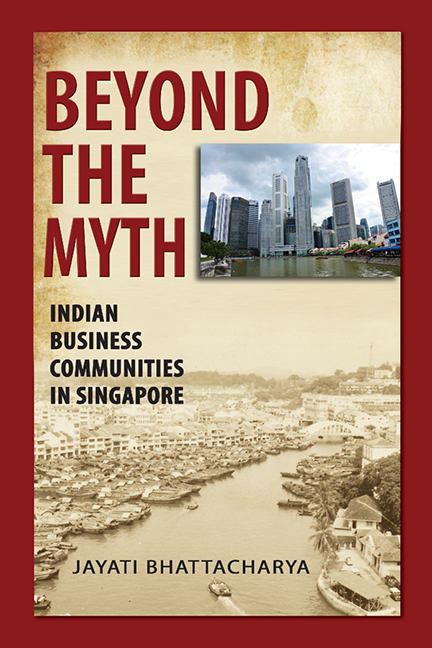Book contents
- Frontmatter
- Dedication
- Contents
- List of Map, Tables and Figures
- Message by Mr R. Narayanmohan
- Foreword by Professor Tan Tai Yong
- Message by Ambassador K. Kesavapany
- Acknowledgements
- List of Abbreviations
- Introduction
- PART ONE
- Chapter One Making Singapore their Homeland: The Early Indian Migrants to the Lion City
- Chapter Two The Post-Independence Period: Changing Dynamics and the Shift in Business Activities
- Chapter Three Taking Strides into the Future: Transition and Transformation of the Indian Business Communities
- PART TWO
- Conclusion: Surging Forward
- Appendices
- Select Bibliography
- Index
- About the Author
Chapter Three - Taking Strides into the Future: Transition and Transformation of the Indian Business Communities
from PART ONE
Published online by Cambridge University Press: 21 October 2015
- Frontmatter
- Dedication
- Contents
- List of Map, Tables and Figures
- Message by Mr R. Narayanmohan
- Foreword by Professor Tan Tai Yong
- Message by Ambassador K. Kesavapany
- Acknowledgements
- List of Abbreviations
- Introduction
- PART ONE
- Chapter One Making Singapore their Homeland: The Early Indian Migrants to the Lion City
- Chapter Two The Post-Independence Period: Changing Dynamics and the Shift in Business Activities
- Chapter Three Taking Strides into the Future: Transition and Transformation of the Indian Business Communities
- PART TWO
- Conclusion: Surging Forward
- Appendices
- Select Bibliography
- Index
- About the Author
Summary
The challenges of modernization and industrialization that were successfully confronted by Singapore soon propelled her to one of the most prominent and economically stable nations of the East. However, at the end of the twentieth century in the post-Cold War scenario, she was further consumed by the resurgence of the two of the greatest ancient civilizations of the world — China and India. They were also two of the largest geographical entities of Asia with huge pools of thriving human resources. The new situation demanded re-establishing equations in dominance and power play amongst the nations and at the same time readjustments and rethinking of their respective foreign and domestic policies. Singapore was quick to respond to the changing circumstances and a globalizing India and its “Look East” policy followed by the new trends of migration offered propitious grounds to believe that the ethnic Indian communities would find new opportunities for competitive performances in professional and business ventures.
Indian economic liberalization preceded by the rapid modernization and opening up of China and the favourable global economic climate have been relevant to commercial groups and businessmen who would now spread their wings outside Singapore with greater confidence and bigger investments. Scepticism of the Indian bureaucratic system and a notion of Chinese impregnability had barred them from entering the respective markets (China opened up much earlier than India) which they could now venture into, given the changes in the approaches of the two giants. Opening up of investment opportunities in the face of improved political relations have also enabled many Indian and Chinese entrepreneurs to come into the region by opening representative offices, joint collaborations or independent corporate ventures. The influx has been quite remarkable in the case of the Indians, who have continued to be a minority population in Singapore. There have been new migrants who are Indian professionals in the field of telecommunications, computer engineering, education and banking, thus creating a new group of ethnic Indian settlers in the diaspora, and not only leading to their increasing importance as players in the economy but also creating sociological complexities.
- Type
- Chapter
- Information
- Beyond the MythIndian Business Communities in Singapore, pp. 139 - 196Publisher: ISEAS–Yusof Ishak InstitutePrint publication year: 2011

